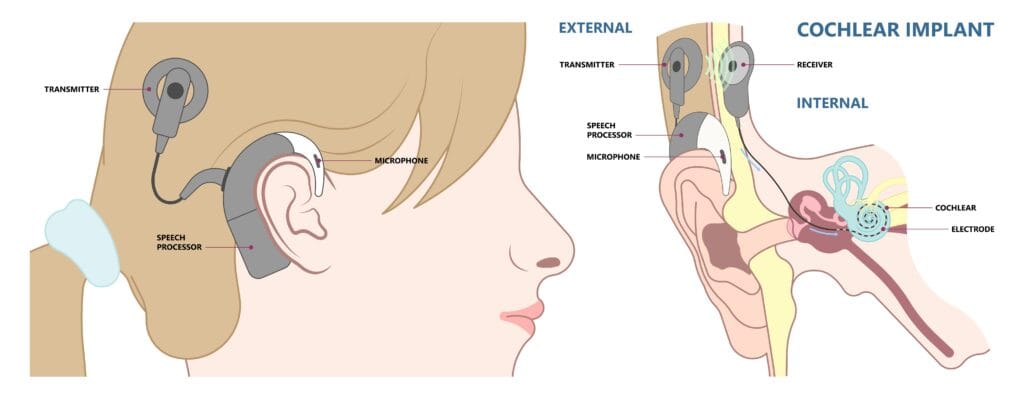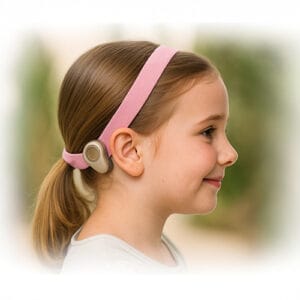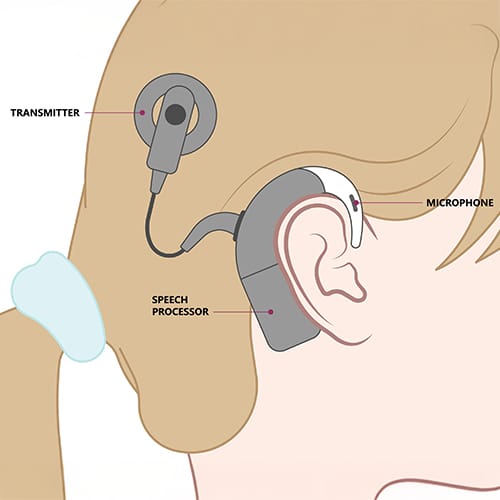Bone Anchored Hearing Aids (BAHA) are changing the way we think about hearing solutions. Designed for people with specific types of hearing loss, such as conductive hearing loss or single-sided deafness, this hearing aid device use bone conduction technology to bypass damaged part of ears and deliver clear sound directly to the inner ear.
Unlike traditional in-the-ear hearing aids or behind-the-ear aids, this implant is anchored behind the ear to the mastoid bone, offering a more direct and effective way to hear. Whether you’re considering a BAHA Hearing Aid NHS option or exploring advanced devices like the BAHA 6, understanding how it works and what to expect is the first step toward better hearing.
In this article, we’ll walk you through everything you need to know about this Hearing Aid
What is BAHA?
A Bone Anchored Hearing Aid is a surgically implanted device designed to help individuals with hearing loss. Unlike traditional hearing aids that amplify sound through the ear canal, this conducting hearing aid transmits sound directly to the inner ear through bone conduction. This method is particularly beneficial for those with conductive or mixed hearing loss, and single-sided deafness.
Key Components of a BAHA System:
- Titanium Implant: Surgically placed into the bone behind the ear, this implant serves as a stable foundation for the system.
- Abutment or Magnetic Attachment: Connects the implant to the external sound processor, facilitating efficient sound transmission.
- External Sound Processor: Captures environmental sounds, converts them into vibrations, and sends these vibrations through the implant to the inner ear.
How Does It Work?
The process begins with the external sound processor capturing sound waves. They are then transformed into vibrations and transmitted through the abutment or magnetic attachment to the titanium implant. The hearing aid conducts these vibrations through the skull bone directly to the cochlea in the inner ear, allowing the auditory nerve to process sounds. This direct transmission bypasses any issues in the outer or middle ear, providing clearer hearing aid for individuals with specific hearing impairments.

BAHA vs. Traditional Hearing Devices:
Traditional hearing aids amplify sounds and direct them through the ear canal, which may not be effective for individuals with certain types of hearing loss. In contrast, the BAHA system uses bone conduction to deliver sound directly to the inner ear, making it a suitable alternative for those who cannot benefit from conventional hearing aids.
Understanding the components and functionality of a BAHA implant is crucial for individuals considering this hearing solution. In the following sections, we will explore more of these implants, providing a complete overview to help you make an informed decision.
Who Can Benefit from a BAHA?
A Bone Anchored Hearing Aid isn’t for everyone, but for the right candidate, it can be life changing. This unique hearing solution is designed to help those whose hearing loss can’t be addressed fully with traditional hearing aids, such as in ear hearing aids or behind-the-ear aids. By bypassing damaged parts of the ear and delivering sound directly to the inner ear, this system provides clear and natural sound quality.
Who is a Candidate?
BAHA implants are suitable for the following:
- Conductive Hearing Loss: When the outer or middle ear prevents sound from reaching the inner ear.
- Single-Sided Deafness (SSD): If you have complete hearing loss in one ear but normal hearing in the other.
- Mixed Hearing Loss: A combination of conductive and sensorineural hearing loss.
- Chronic Ear Infections or Ear Canal Issues: If wearing traditional hearing aids is uncomfortable or leads to recurring problems.
Also, this system is particularly beneficial for those who struggle with traditional hearing aids attached to the head or inner ear hearing aids because it offers a direct and comfortable alternative.
How to Know if BAHA is Right for You?
Your journey begins with an ENT specialist who can assess your specific hearing needs. They will evaluate whether this procedure is suitable for your type of hearing loss. This includes tests to decide if your hearing can improve with bone conduction technology.
Temporary Solutions Before Surgery
If you’re not ready for surgery or want to evaluate how a BAHA device might feel, you can try bone conduction hearing aid headband. This device offers a non-surgical option to experience the benefits of bone conduction hearing.
Making the Decision
Choosing a BAHA implant is a personal decision, but with the guidance of a specialist, you can figure out if it’s the right choice for you. For those who qualify, it’s a step toward clearer, more natural hearing that can significantly improve quality of life. We will be discussing more about these implants to help you make an informed choice.
Advantages of a BAHA
A Bone Anchored Hearing Aid offers a unique approach to hearing improvement, and for many people, it’s a game changer. Unlike traditional in-the-ear hearing aids (ITE) or behind-the-ear aids (BTE), Bone Anchored Hearing Aid implants utilise bone conduction technology to deliver sound directly to the inner ear. Here are some of the key benefits:
Clearer Sound Quality
By bypassing damaged parts of the ear, a BAHA implant provides direct sound transmission to the cochlea, resulting in clearer, more natural sound. This can be particularly beneficial for people with conductive hearing loss or single-sided deafness.
Better Comfort
Traditional hearing aids can cause discomfort, especially for those with ear infections or ear canal issues. The BAHA system eliminates this problem by attaching to the bone rather than sitting in the ear canal.
Enhanced Speech Understanding
With less background noise interference, many users report better speech clarity in noisy environments. This makes it easier to take part in conversations and social activities.
Long-Term Solution
A this implant is designed to be a durable, long-term option for hearing loss. Once the implant is in place, the external processor can be upgraded as new technology becomes available.
Non-Surgical Options
For those not ready for surgery, there are devices that offer a non-invasive way to experience the benefits of bone conduction hearing.

Disadvantages of a BAHA
While a BAHA implant has many benefits, it’s important to consider potential downsides:
Surgical Risks
As with any surgery, there are risks involved, including infection, implant failure, or complications during the healing process.
Cost Considerations
While some patients may qualify for a BAHA Hearing Aid NHS option, others may need to pay for the procedure and device privately, which can be expensive.
Maintenance and Care
The external sound processor requires regular cleaning and occasional replacement of parts, which adds to the ongoing costs.
Adjustment Period
Some users may need time to adjust to the sensation of sound transmitted through bone conduction, which can feel different from traditional hearing.
Visibility of the Device
Although modern BAHA devices are designed to be discreet, they are still more visible than invisible hearing aids or smaller, inner ear hearing aids.
The Surgical Process
Getting a BAHA implant involves a straightforward surgical procedure performed by an ENT specialist or surgeon. While the idea of surgery might feel overwhelming, understanding what happens before, during and after process can help ease any concerns.
Before the Surgery
Your journey will begin with a detailed consultation with your audiologist or ENT surgeon. They will do the following:
- Conduct hearing tests to confirm if a BAHA implant is the best solution for your needs.
- Do a detailed discussion of your medical history to ensure you are a suitable candidate for the procedure.
- Explain the different types of implants, such as magnetic BAHA hearing aid or abutment-based systems.
Before the surgery, you may also get the chance to try a bone conduction hearing aid without surgery, to understand how the implant will work.
During the Surgery
The procedure itself is relatively quick and performed under local or general anaesthesia, depending on your preference and medical condition.
- A small titanium implant is inserted into the bone behind your ear.
- If you’ve opted for a magnetic system, a magnet is placed under the skin to connect with the external sound processor.
- The surgery typically takes about one to two hours, and you can go home the same day in most cases.
After the Surgery
Recovery is usually smooth, with some patients experiencing mild discomfort or swelling around the implant site.
- The healing process takes about 4–6 weeks, during which the implant fuses with the bone.
- Once healed, your ENT will attach the external BAHA sound processor and program it according to your hearing needs.
- Regular follow-ups will ensure everything is working well.
Tips for a Smooth Recovery
- Keep the surgical area clean and dry to prevent infection.
- Follow your doctor’s advice on managing pain and caring for the wound.
- Avoid vigorous activities until your surgeon gives you the go-ahead.
What to Expect After Activation
Once the sound processor is activated, most patients notice an immediate improvement in their hearing. However, it may take a few weeks to fully adjust to the sensation of sound transmitted via bone conduction. The ENT specialists often schedule follow ups to fine tune the settings for optimal performance.
We’ll explore how the BAHA system compares to other hearing aids, helping you decide if it’s the right solution for your needs.
BAHA vs Other Hearing Aids
When it comes to choosing the right hearing solution, understanding the differences between a Bone Anchored Hearing Aid and traditional hearing aids is essential. Both options are designed to improve hearing, but they work in fundamentally different ways. Here’s how the Bone Anchored Hearing Aid system stacks up against other popular options like in-ear hearing aids, behind-the-ear aids, and invisible hearing aids.
Technology
BAHA Implant:
Uses bone conduction technology, bypassing the damaged outer or middle ear and transmitting sound directly to the inner ear. This is ideal for individuals with conductive hearing loss or single-sided deafness.
Traditional Hearing Aids:
Amplify sound and deliver it through the ear canal. These are best for sensorineural hearing loss, where the issue lies in the inner ear or auditory nerve.
Placement and Comfort
BAHA Hearing Aid:
Anchored to the bone behind the ear, it avoids the discomfort often associated with ear canal hearing aids. This makes it a great choice for people with chronic ear infections or sensitivity to traditional aids.
Other Hearing Aids:
Devices like inner ear hearing aids or behind-the-ear aids rest in or around the ear canal, which can sometimes lead to irritation or feedback issues.
Sound Quality
BAHA System:
Offers clearer and more natural sound by eliminating obstructions in the outer and middle ear. This is particularly beneficial in noisy environments, where speech understanding can be improved.
Conventional Aids:
While effective for amplifying sound, they may struggle with clarity in noisy settings.
Suitability for Different Conditions
Bone Anchored Hearing Aid:
Perfect for individuals with conductive hearing loss, mixed hearing loss, or single-sided deafness. It’s also an option for those who can’t wear traditional aids due to ear canal problems.
Other Hearing Aids:
Best for individuals with mild to severe sensorineural hearing loss and those looking for a more discreet device like invisible hearing aids.
Maintenance and Longevity
Bone Anchored Hearing Aid Device:
The external sound processor needs regular maintenance, but the implant itself is designed to last for many years.
Traditional Hearing Aids:
Require regular cleaning, battery changes, and occasional replacement due to wear and tear.
Conclusion: Is a BAHA Implant Right for You?
Choosing the right hearing aid is a personal decision, and understanding your options is key to making an informed choice. If you have conductive hearing loss, single-sided deafness, or mixed hearing loss, a Bone Anchored Hearing Aid might be the solution you’ve been looking for. Unlike traditional hearing aids that amplify sound through the ear canal, the BAHA system uses bone conduction technology to transmit sound directly to the inner ear, providing a clearer, more natural hearing experience.

Key Takeaways
- BAHA hearing aid are ideal for individuals who struggle with traditional hearing aids or have conditions like single-sided deafness or chronic ear problems.
- The surgical procedure is relatively straightforward, and recovery is typically quick, allowing most users to start benefiting from their BAHA implant in just a few weeks.
- Advantages include better sound clarity, improved comfort, and a long-term, reliable solution for hearing loss.
- Disadvantages include the risks of surgery, ongoing maintenance, and costs.
- If you’re looking for a more discreet, non-surgical option, then consult a surgeon and they can give you a bone conduction hearing before committing to surgery.
Could a BAHA Hearing Aid be the solution you’ve been searching for? Contact us today to learn more!
FAQ
How much does a BAHA device cost?
The cost of BAHA devices ranges from basic models to advanced options with features like Bluetooth. Consult your audiologist to find the best solution.
What is the most discreet cochlear implant?
The Cochlear Osia System and magnetic BAHA implants are considered among the most discreet hearing solutions. They offer advanced bone conduction technology while remaining minimally visible.
How long does BAHA hearing aid last?
A BAHA hearing aid implant is designed to last a lifetime, while the external sound processor may need periodic upgrades or replacements. Regular maintenance ensures best performance of the BAHA system.
How do I wash my hair after BAHA surgery?
After BAHA surgery, wash your hair carefully, avoiding the surgical site until it heals, typically 4–6 weeks post-operation. Follow your surgeon’s guidelines to keep the area clean and prevent infection.
Are there any long-term complications of BAHA implants?
Long-term complications of BAHA implants are rare but may include skin irritation, infection around the abutment, or device failure. Regular follow-ups with your ENT specialist can help prevent and address such issues promptly.
